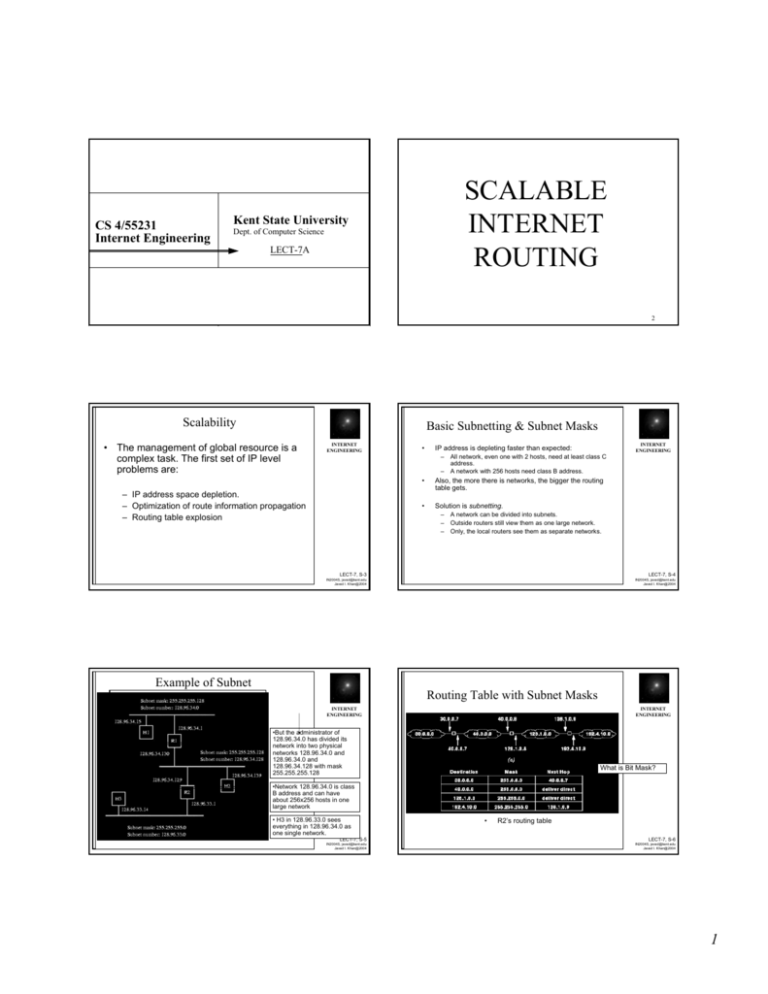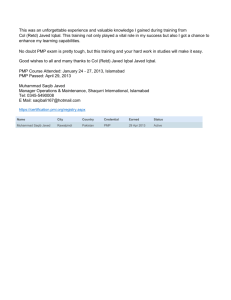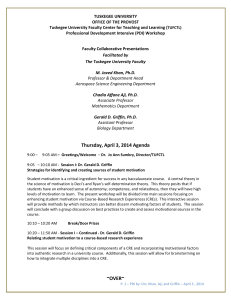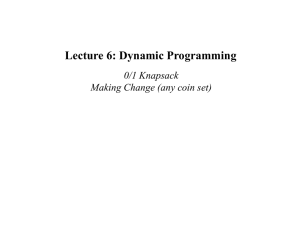L07A - Computer Science
advertisement

CS 4/55231 Internet Engineering SCALABLE INTERNET ROUTING Kent State University Dept. of Computer Science LECT-7A 1 2 Scalability Basic Subnetting & Subnet Masks • The management of global resource is a complex task. The first set of IP level problems are: INTERNET ENGINEERING • IP address is depleting faster than expected: – – – IP address space depletion. – Optimization of route information propagation – Routing table explosion All network, even one with 2 hosts, need at least class C address. A network with 256 hosts need class B address. • Also, the more there is networks, the bigger the routing table gets. • Solution is subnetting. – – – INTERNET ENGINEERING A network can be divided into subnets. Outside routers still view them as one large network. Only, the local routers see them as separate networks. LECT-7, S-3 LECT-7, S-4 IN2004S, javed@kent.edu Javed I. Khan@2004 IN2004S, javed@kent.edu Javed I. Khan@2004 Example of Subnet Routing Table with Subnet Masks INTERNET ENGINEERING INTERNET ENGINEERING •But the administrator of 128.96.34.0 has divided its network into two physical networks 128.96.34.0 and 128.96.34.0 and 128.96.34.128 with mask 255.255.255.128 What is Bit Mask? •Network 128.96.34.0 is class B address and can have about 256x256 hosts in one large network • H3 in 128.96.33.0 sees everything in 128.96.34.0 as one single network. • R2’s routing table LECT-7, S-5 LECT-7, S-6 IN2004S, javed@kent.edu Javed I. Khan@2004 IN2004S, javed@kent.edu Javed I. Khan@2004 1 IP Address Space Depletion • • The growing demand for IP addresses has put a strain on the classfull model, specially class B space, which is depleting rapidly. IP Address Allocation INTERNET ENGINEERING Solution Proposals • Class A is very limited in number. Upper range A 64-127 will be distributed but there is still no plan on how. • Class B addresses are also restricted. They will be allocated only if the need can be justified. Due to low utilization, the recommendation is to allocate blocks of class C addresses. Class C is now being distributed in way which is compatible with address aggregation techniques. • – Creative IP address space allocation. – Classless Inter domain Routing (CIDR). – Private Addressing Network Address. Translation (NAT). • Class C are being distributed to ISPs with the requirement that the original allocation for the provider should last atleast two years. – IPv6. – Each ISP must allocate half from its old address space for new customer request. A customer will not be granted new address space if its current allocation is less than 80%. – LECT-7, S-7 IN2004S, javed@kent.edu Javed I. Khan@2004 Subnet Masks • A customer can receive a class-B if its requirement is more than 4096 IP addresses. • Follow the geographical allocation of blocks in class C addresses: – – – – – – – – • This is an attempt to remove the classification of IP addresses. The motivation is twofold: – – INTERNET ENGINEERING Multiregional 192.0.0.0 to 193.255.255.255 Europe 194.0.0.0 to 195.255.255.255 Others 196.0.0.0 to 197.255.255.255 North America 198.0.0.0 to 199.255.255.255 Cen/South America 200.0.0.0 to 203.255.255.255 Pacific Rim 202.0.0.0 to 204.255.255.255 Others 204.0.0.0 to 205.255.255.255 Others 206.0.0.0 to 207.255.255.255 LECT-7, S-9 LECT-7, S-10 IN2004S, javed@kent.edu Javed I. Khan@2004 IN2004S, javed@kent.edu Javed I. Khan@2004 Classless Interdomain Routing • LECT-7, S-8 IN2004S, javed@kent.edu Javed I. Khan@2004 IP Address Allocation (cont.) INTERNET ENGINEERING •Now in each routing table both the network number and the mask is stored. •An AND operation is performed before looking up for the next hop. •For distant networks, the mask is of type A, B, or C. But for local network, the mask is longer. INTERNET ENGINEERING Classless Internet Routing INTERNET ENGINEERING • Better utilization of network addresses. Handle the route table explosion problem. • IP address is represented as the IP and a count of leftmost contiguous bits. Example: – 198.32.0.0/16 – similar to 198.32.0.0 with mask 255.255.0.0, but the length can be any number. INTERNET ENGINEERING “Supernet” CIDR Block and Aggregate: – A network is classed as supernet when the prefix boundary contains fewer bits than the networks natural mask. – 198.32.0.0/16 is a supernet to 198.32.1.0 with a natural mask 255.255.255.0. – CIDR block, aggregate, and supernet all refers to a specific block of contiguous IP addresses. LECT-7, S-11 LECT-7, S-12 IN2004S, javed@kent.edu Javed I. Khan@2004 IN2004S, javed@kent.edu Javed I. Khan@2004 2 Classless Internet Routing • “More specific” network – – • INTERNET ENGINEERING INTERNET ENGINEERING CIDR Routing Domains – • All the networks that are a subset of an aggregate or a CIDR block are called “more specific” because they give more information about the location of a network. Example: 198.213.0.0/16 -aggregate of length 16, while 198.213.1.0/20 is more specific prefix of length 20. Advantage of CIDR (1/2) routing domains which are CIDR capable are called classless. Hierarchical Internet Architecture – – CIDR provides more efficient means for building hierarchical network architecture. It tremendously saves route propagation in leaf networks. LECT-7, S-13 LECT-7, S-14 IN2004S, javed@kent.edu Javed I. Khan@2004 IN2004S, javed@kent.edu Javed I. Khan@2004 Advantage of CIDR (2/2) Aggregation is not Always Easy INTERNET ENGINEERING • – Routing to all destinations is always done on a longest match basis. – A router that has to decide between two different length prefixes of the same network will always follow the longer mask. Example: – – – – Aggregation works optimally if every customer is single homed and they takes their address from their providers address space only. • However, this is not always the case in real world. The real world routing is much complex with CIDR. INTERNET ENGINEERING LECT-7, S-15 LECT-7, S-16 IN2004S, javed@kent.edu Javed I. Khan@2004 IN2004S, javed@kent.edu Javed I. Khan@2004 Routing Rule: Router Loop Routing Rules • Longest Match Rule • INTERNET ENGINEERING • Exception Rule – A network must not follow a less specific route, if that route is part of its own aggregation. – Use pit-bucket. INTERNET ENGINEERING A router has two matching entries: 198.32.1.0/24 via path 1 198.32.0.0/16 via path 2 Router should forward via path 1 LECT-7, S-17 LECT-7, S-18 IN2004S, javed@kent.edu Javed I. Khan@2004 IN2004S, javed@kent.edu Javed I. Khan@2004 3 Routing Rule: Black Hole • A black hole occurs when traffic reaches and stops at destination that is not its intended destination, and it cannot be forwarded out of it. • It Can occur: INTERNET ENGINEERING INTERNET ENGINEERING – Single Homing Scenario: when a customer network borrows IP address from address space which is not part of its providers address space. • – Multi Homing Scenario: when a customer is connected via two providers but has IP address from one. LECT-7, S-19 LECT-7, S-20 IN2004S, javed@kent.edu Javed I. Khan@2004 IN2004S, javed@kent.edu Javed I. Khan@2004 Routing Rule: Black Hole • ISP2’s is aggregating Lindanet and Jamesnet’s addresses and advertising the aggregate. This aggregation, unfortunately erroneously implies that Stabnet as well can be reached from ISP2. Problem: Partial Reachability Never aggregate the address spaces of other Routing Domains., advertise explicitly. INTERNET ENGINEERING INTERNET ENGINEERING • • Costing? ISP1 or ISP2, who is going to receive the traffic for Jamesnet and Lindanet? LECT-7, S-21 LECT-7, S-22 IN2004S, javed@kent.edu Javed I. Khan@2004 IN2004S, javed@kent.edu Javed I. Khan@2004 Problem: Irregular IP allocation Aggregation Recommendations INTERNET ENGINEERING • • • In many situation a large network will have IP addresses from more than one ISPs. In that case both ISPs must explicitly advertise the address space allocated by the other to its customer. Otherwise, there will be partial outage. The customer has IP address which belong to none of the ISPs attached to it. This will prevent aggregation. • • • A domain that has been allocated a range of addresses has the sole authority for aggregation of its address space. When a domain performs aggregation, it should aggregate as much as possible. Different situation requires different design. No one solution can handle all situation. The introduction if CIDR has helped dampening the explosion of global routing tables. BGP4 is the routing protocol of choice that helps efficient handling of route aggregation and propagation. INTERNET ENGINEERING LECT-7, S-23 LECT-7, S-24 IN2004S, javed@kent.edu Javed I. Khan@2004 IN2004S, javed@kent.edu Javed I. Khan@2004 4 Private Addressing • Global vs. Local connectivity. • IANA allocated few addresses for local use: – ATM, cash registers etc. may never require global connectivity. Network Address Translation INTERNET ENGINEERING • – – – 10.0.0.0-10.255.255.255 ( one class A network) – 172.16.0.0-172.31.255.255 (16 class B networks) – 192.168.0.0-192.168.255.255 (256 class C networks) • NAT routers – These addresses can be reused provided they do not communicate to the outside world, and they are connected via a filtering gateway. • IP V6 allocates 128 bits (compared to 32 bits in IPv4) to address the problem of IP address depletion. INTERNET ENGINEERING • A and B have IP addresses 10.1.1.1 and 10.1.1.2. If A and B want to reach outside the router will automatically change their IP addresses into a valid global IP 128.21.3.x.y. A smaller pull of IPs can be reused. LECT-7, S-25 LECT-7, S-26 IN2004S, javed@kent.edu Javed I. Khan@2004 IN2004S, javed@kent.edu Javed I. Khan@2004 IP v6 • placed at the border of a domain enables private networks to connect to the Internet without resorting to tedious renumbering of the hosts. translates the private address into global addresses before sending packets out. IP v6 INTERNET ENGINEERING • A provider based unicast address has FP =010. It is subdivided into following fields: – – – – – IPV6 also has also definition for multiple classes of addresses. It is indicated by a variable length FP (Format Prefix) field. INTERNET ENGINEERING REGISTRY ID PROVIDER ID SUBSCRIBER ID SUBNET ID INTERFACE ID (it can be MAC address as well). LECT-7, S-27 LECT-7, S-28 IN2004S, javed@kent.edu Javed I. Khan@2004 IN2004S, javed@kent.edu Javed I. Khan@2004 IP v6 Link Local and Site Local IP INTERNET ENGINEERING • • • Link local addresses are private to a particular physical network. Site local addresses are private to a particular site. INTERNET ENGINEERING Quiz: What if later on the company decides to make these addresses global? LECT-7, S-29 LECT-7, S-30 IN2004S, javed@kent.edu Javed I. Khan@2004 IN2004S, javed@kent.edu Javed I. Khan@2004 5 Basic Concepts (1) • Internet Interconnection Structure Internet Service Provider (ISP) – Provider who connects an end user customer with the Internet in one or few geographic regions. • INTERNET ENGINEERING National & Regional Provider (NP and RP) – Provider who connects two or more ISP networks across regions. • Point-of-Presence (POP) – An access point where a customer can connect into an ISP network. LECT-7, S-32 IN2004S, javed@kent.edu Javed I. Khan@2004 31 Concepts (POP, ISP, NP) Basic Concepts (2) INTERNET ENGINEERING • National Access Point (NAP) – The facility where various NPs networks can interconnect. INTERNET ENGINEERING – Formerly these were organized as Federal Internet Exchange (FIX) & Commercial Internet Exchange (CIX). FIX/CIX model did not scale well. – It is physically a high-speed network switch or network to which a number of routers can be connected for the purpose of traffic exchange (example: FDDI or ATM switch). LECT-7, S-33 LECT-7, S-34 IN2004S, javed@kent.edu Javed I. Khan@2004 IN2004S, javed@kent.edu Javed I. Khan@2004 NAP Basic Concepts (3) INTERNET ENGINEERING • Route Server – Route server exchanges routing information and policy with the service provider routers attached to the NAP. INTERNET ENGINEERING – It does not perform any traffic forwarding. – A group of servers facilitates interconnections between ISPs by gathering routing information from each ISP applying ISPs predefined set of rules, policies, and then redistributing the processed information to each ISP. LECT-7, S-35 IN2004S, javed@kent.edu Javed I. Khan@2004 – It saves routers of each individual ISPs to peer with all other routers, thus cutting down the number of peers from (n01) to 1. LECT-7, S-36 IN2004S, javed@kent.edu Javed I. Khan@2004 6 Route Server ISP-Customer Connectivity (1) INTERNET ENGINEERING • – • Each ISP should have ample bandwidth to provide service to all its customers. Access Redundancy – ISP connected via multiple NAP will be more reliable than the one with one. LECT-7, S-37 LECT-7, S-38 IN2004S, javed@kent.edu Javed I. Khan@2004 IN2004S, javed@kent.edu Javed I. Khan@2004 ISP-Customer Connectivity (1) • Demarcation Point – A demarcation point is the point that differentiates a curtomers network from that of the provider. INTERNET ENGINEERING ISP Bottleneck Demarcation Models INTERNET ENGINEERING INTERNET ENGINEERING ISP provides CSU/DSU customer provides router Customer provides every thing ISP provides all Customer router at providers site LECT-7, S-39 LECT-7, S-40 IN2004S, javed@kent.edu Javed I. Khan@2004 ISP router at customer site IN2004S, javed@kent.edu Javed I. Khan@2004 Autonomous System • Autonomous Systems Autonomous Systems – INTERNET ENGINEERING An autonomous system (AS) is a set of routers having a single routing policy, running under a single technical administration. Each AS has its own internal routing mechanism and policy. Each AS has a unique number registered at IANA. LECT-7, S-42 41 IN2004S, javed@kent.edu Javed I. Khan@2004 7 Divide the Routing • Interior Routing Protocol • – The routing protocol(s) that an AS use internally to route its packets are knows as Interior Gateway Protocols or IGP. – Examples: RIP, OSPF IGP and BGP INTERNET ENGINEERING INTERNET ENGINEERING Exterior Routing Protocol – The routing protocol that the AS use to exchange traffics between them is called Exterior Gateway Protocol or EGP. – Example: BGP LECT-7, S-43 LECT-7, S-44 IN2004S, javed@kent.edu Javed I. Khan@2004 IN2004S, javed@kent.edu Javed I. Khan@2004 AS Connectivity • Stab Autonomous System – An Autonomous System is called a stub, when it reaches networks outside its domain via a single exit point. These are also called single homed AS. – A Stab AS does not really have to learn Internet routes from its provider. All traffic can be default routed to provider. Routing Alternatives for Stab AS INTERNET ENGINEERING • Static, IGP, or EGP: • Options with a Customer Router LECT-7, S-45 LECT-7, S-46 IN2004S, javed@kent.edu Javed I. Khan@2004 IN2004S, javed@kent.edu Javed I. Khan@2004 Multi-homed AS • Multi-homed Non-transit AS – – An AS is multi-homed if it has more than one exit point to the outside world. A non-transit router does not allow traffic of of any source or destination that is outside the AS. INTERNET ENGINEERING Multi-homed AS • INTERNET ENGINEERING Multi-homed Non-transit AS – – It will advertise only its own routes, not the one learned from the other ASs. Example: AS1 only advertises n1 and n2. INTERNET ENGINEERING • ISP1 and ISP2 still can force packets in AS1 by static route. Like single homed routers, here also EGP is not required between AS1 and providers.. However, is recommended. • AS1 can however, filter packets. LECT-7, S-47 LECT-7, S-48 IN2004S, javed@kent.edu Javed I. Khan@2004 IN2004S, javed@kent.edu Javed I. Khan@2004 8 Multi-homed Transit AS • Multi-homed Transit AS – • A multi-homed transit router is connected to more than one provider. It allows traffic with origin and destination that does not belong to it. Multi-homed Transit AS INTERNET ENGINEERING • For handling transit traffic an AS creates ‘pipe’ between two border routers who are also transit routers. INTERNET ENGINEERING Some additional concepts: – – – – Border Router: Routers those run EGP IBGP: For transit traffic an AS runs an internal version of EGP, it is called Interior Border Gateway Protocol (IBGP). Transit Router: Routers those run IBGP. For handling transit traffic an AS creates ‘pipe’ between two border routers who are also transit routers. LECT-7, S-49 LECT-7, S-50 IN2004S, javed@kent.edu Javed I. Khan@2004 IN2004S, javed@kent.edu Javed I. Khan@2004 Next Topic: BGP4 51 9





